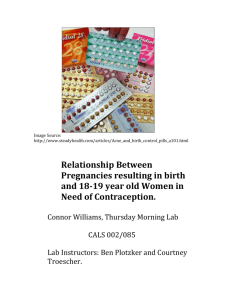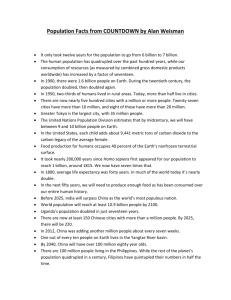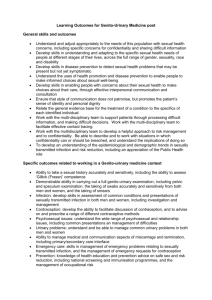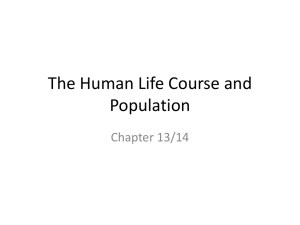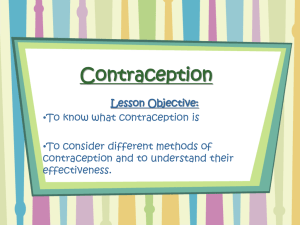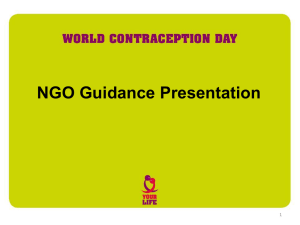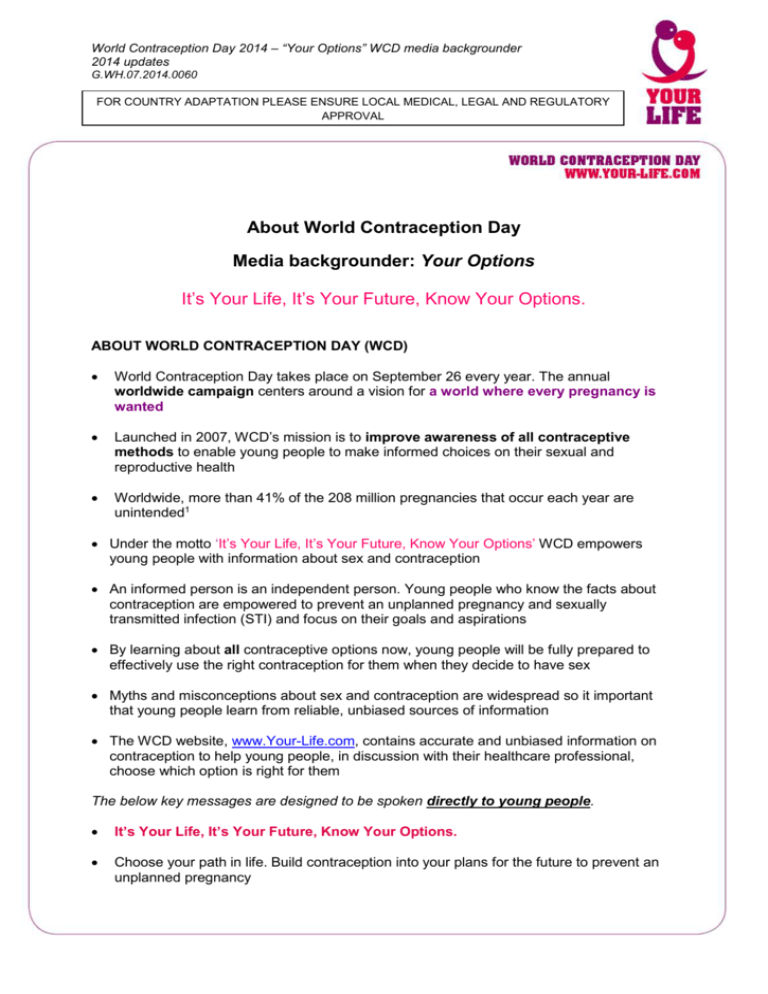
World Contraception Day 2014 – “Your Options” WCD media backgrounder
2014 updates
G.WH.07.2014.0060
FOR COUNTRY ADAPTATION PLEASE ENSURE LOCAL MEDICAL, LEGAL AND REGULATORY
APPROVAL
About World Contraception Day
Media backgrounder: Your Options
It’s Your Life, It’s Your Future, Know Your Options.
ABOUT WORLD CONTRACEPTION DAY (WCD)
World Contraception Day takes place on September 26 every year. The annual
worldwide campaign centers around a vision for a world where every pregnancy is
wanted
Launched in 2007, WCD’s mission is to improve awareness of all contraceptive
methods to enable young people to make informed choices on their sexual and
reproductive health
Worldwide, more than 41% of the 208 million pregnancies that occur each year are
unintended1
Under the motto ‘It’s Your Life, It’s Your Future, Know Your Options’ WCD empowers
young people with information about sex and contraception
An informed person is an independent person. Young people who know the facts about
contraception are empowered to prevent an unplanned pregnancy and sexually
transmitted infection (STI) and focus on their goals and aspirations
By learning about all contraceptive options now, young people will be fully prepared to
effectively use the right contraception for them when they decide to have sex
Myths and misconceptions about sex and contraception are widespread so it important
that young people learn from reliable, unbiased sources of information
The WCD website, www.Your-Life.com, contains accurate and unbiased information on
contraception to help young people, in discussion with their healthcare professional,
choose which option is right for them
The below key messages are designed to be spoken directly to young people.
It’s Your Life, It’s Your Future, Know Your Options.
Choose your path in life. Build contraception into your plans for the future to prevent an
unplanned pregnancy
World Contraception Day 2014 – “Your Options” WCD media backgrounder
2014 updates
G.WH.07.2014.0060
Information means independence. Know the facts about contraception so that you can
prevent an unplanned pregnancy and focus on achieving your goals
Contraception should not be a last-minute choice, but an informed decision. Learn
about all contraceptive options and talk to your partner and healthcare provider about
choosing the best contraceptive option for you
Get your facts straight. Myths and misconceptions about sex, contraception and how
pregnancies happen are everywhere. Challenge what you’ve heard, use a reliable source
of information and talk to your healthcare provider to sort fact from fiction
Talk to your healthcare provider and visit the WCD website, www.Your-Life.com, for help
with deciding on the best contraceptive option for you
For protection against STIs as well as unplanned pregnancy, use a condom in addition to
another contraceptive option
INTERNATIONAL SUPPORT FOR WCD
Around 70 countries are expected to participate in World Contraception Day
WCD is supported by a coalition of 11 international NGOs and scientific and medical
societies with an interest in sexual and reproductive health and is sponsored by Bayer
HealthCare. The NGOs and GO involved in WCD are:
o
o
o
o
o
o
o
o
o
o
o
Asian Pacific Council on Contraception (APCOC)
Centro Latinamericano Salud y Mujer (CELSAM)
European Society of Contraception and Reproductive Health (ESC)
DSW (Deutsche Stiftung Weltbevölkerung)
International Federation of Pediatric and Adolescent Gynecology (FIGIJ)
International Planned Parenthood Federation (IPPF)
Marie Stopes International (MSI)
Population Services International (PSI)
The Population Council
The United States Agency for International Development (USAID)
Women Deliver (WD)
World Contraception Day is a long-term initiative which highlights and addresses the
different contraceptive needs of women and men throughout their lives
For more information on the WCD campaign, please go to the WCD website, www.YourLife.com, which provides information on a variety of topics including sex and
contraception
World Contraception Day 2014 – “Your Options” WCD media backgrounder
2014 updates
G.WH.07.2014.0060
BAYER’S COMMITMENT TO SEXUAL AND REPRODUCTIVE HEALTH
Bayer HealthCare is committed to supporting World Contraception Day to improve the
level of education on sexual and reproductive health
Bayer HealthCare has a long history in women’s health and is committed to improving
education on sexual and reproductive health
THE SCALE OF THE PROBLEM – UNPLANNED PREGNANCIES AND STIS
Incidence of unplanned pregnancies and sexually transmitted infections
Worldwide, more than 41% of the 208 million pregnancies that occur each year are
unplanned1
Every year, up to 16 million adolescent females aged 15 to 19 give birth. In this age
group, pregnancy-related deaths are the leading cause of mortality for young women2
Each year, contraception prevents 188 million unplanned pregnancies which results in
112 million fewer abortions, 1.1 million fewer newborn deaths and 150,000 fewer
maternal deaths3
More than half of all women of reproductive age in developing countries, approximately
867 million, want to avoid pregnancy. In this region, a total of 222 million women have an
unmet need for modern contraception3
If unmet need for contraception was fully satisfied, 53 million more unplanned
pregnancies could be prevented every year4
In 2011, teenagers in the United States and United Kingdom were over six times more
likely to give birth than teenagers in the Netherlands5
More than 1 million people acquire a sexually transmitted infection every day. Each year,
an estimated 500 million people acquire one of four sexually transmitted infections:
chlamydia, gonorrhoea, syphilis and trichomoniasis. This does not include HIV and other
STIs which continue to adversely affect the lives of individuals and communities
worldwide6
STIs disproportionately affect women and adolescent girls. One in 20 adolescent girls get
a bacterial infection through sexual contact every year and the age at which infections
are acquired is getting younger7
Young adults (15-24 years old) make up only 25% of the sexually active population, but
represent almost 50% of all new acquired sexually transmitted diseases8
World Contraception Day 2014 – “Your Options” WCD media backgrounder
2014 updates
G.WH.07.2014.0060
Impact of unplanned pregnancies and sexually transmitted infections
Unplanned pregnancies constitute a global problem associated with substantial costs to
health and social services and emotional distress to women, their families and society9
Children born to teenage mothers are much more likely to experience a range of negative
outcomes in later life, such as developmental disabilities, behavioral issues and poor
academic performance10
The 1990s witnessed significant gains in access to reproductive health and family
planning, but in many less developed countries (LDCs), particularly from Africa, the
progress has come to a stand-still since about 200011
Investing in both family planning and maternal and newborn health services would save
lives and $1.5 billion less than providing maternal and newborn services alone12
Every £1 invested in contraception saves the UK National Health Service £11 plus
additional welfare costs, which is a powerful economic argument for maintaining
contraceptive services13
Teen childbearing in the United States costs taxpayers (federal, state, and local) at least
$9.4 billion annually14
Young people’s sexual behavior
44% of young people prioritize personal hygiene, including showering, waxing and
applying perfume, above contraception when preparing for a date that may lead to sex15
Studies show that young people do not consider the internet the most trustworthy source
of information about contraception16
Embarrassment is a key risk factor in young people's sexual behavior. This can mean
that they resist seeking information and advice about sex and contraception17
School-based sex education delays rather than hastens the onset of sexual activity18
FACTS AROUND THE WCD THEME – KNOW YOUR OPTIONS
Figure 1 shows a comparison of the typical effectiveness of contraceptive methods.19
World Contraception Day 2014 – “Your Options” WCD media backgrounder
2014 updates
G.WH.07.2014.0060
Figure 1: Comparison of the typical effectiveness of contraceptive methods
Source: World Health Organization 2012
In the UK, the NHS offers 15 different methods of contraception with the pill and the
condom being the preferred choices20,21
Over 90% of people in the UK cannot name the 15 types of contraception options
available to them22
Nearly half of young women (44% of 16-24 year olds) are not aware they might not be
using contraception that is the best ‘fit’ for their age and lifestyle22
Almost a quarter (23%) of young people admit they have unanswered questions about
contraception and sexual health (female 23% and male 23%)22
Nearly a quarter of people (23%) choose their contraception without asking for the
options first (female 21% and male 28%)22
HOW WILL WCD BE RECOGNIZED AROUND THE WORLD?
A series of media events will be taking place in different countries around the world, as
well as a variety of other local activities, including school / college and healthcare
professional campaigns.
In [INSERT COUNTRY], WCD will be celebrated by [INSERT LOCAL DETAILS]
World Contraception Day 2014 – “Your Options” WCD media backgrounder
2014 updates
G.WH.07.2014.0060
For further information, please visit www.Your-Life.com or contact:
[insert name]
[insert title]
Bayer HealthCare
Phone: [insert number]
E-mail: [insert email address]
Suru Douglas
Ketchum, London
Phone: +44 (0) 20 7611 3835
E-mail: suru.douglas@ketchum.com
REFERENCES
1
Singh, S., et al. Unintended pregnancy: worldwide levels, trends, and outcomes. Stud Fam Plann
(2010)41(4): 241-250
2 Blake, S., et al., Youth Guide for Action on Maternal Health, Women Deliver 2010
3 Darroch, J., et al. Trends in contraceptive need and use in developing countries in 2003, 2008, and
2012: an analysis of national surveys. The Lancet. 2013; 381(9879): 1756-1762
4 Every Woman, Every Child http://www.everywomaneverychild.org/resources/un-commission-on-lifesaving-commodities/life-saving-commodities/implants (Last accessed May 2014)
5 United Nations Statistics Division Child Bearing indicators, 2011.
http://unstats.un.org/unsd/demographic/products/socind/ (Last accessed May 2014)
6 WHO. Sexually transmitted infections. Factsheet no 110, Updated November 2013.
http://www.who.int/mediacentre/factsheets/fs110/en/index.html (Last accessed May 2014)
7 WHO 10 facts on sexually transmitted infections, WHO Fact File
http://www.who.int/features/factfiles/sexually_transmitted_diseases/facts/en/index2.html (Last
accessed May 2014)
8 Ros et al., Global epidemiology of sexually transmitted diseases. Asian J Androl. 2008
Jan;10(1):110-4.
9 Mavranezouli I et al. Health economics of contraception. Best Practice & Research Clinical
Obstetrics and Gynaecology 2008;23:187-198 (Abstract Only)
10 Hofferth, S., et al. Early childbearing and Children’s Achievement and Behavior Over Time.
Perspectives on Sexual and Reproductive Health. 2002; 34(1): 41-49
11 Population Dynamics in the Least Developed Countries: Challenges and Opportunities for
Development and Poverty Reduction, United Nations population fund, 2011
12 Alan Guttmacher Institute & IPPF, Facts on Investing in Family Planning and Maternal and Newborn
Health, November 2010.
13 TEENAGE PREGNANCY INDEPENDENT ADVISORY GROUP FINAL REPORT, Teenage
pregnancy: Past successes – future challenges. 2010.
https://www.education.gov.uk/publications/eOrderingDownload/Past%20successes%20%20future%20challenges.pdf (Last accessed May 2014)
14 NATIONAL CAMPAIGN TO PREVENT TEEN PREGNANCY, 2010
http://thenationalcampaign.org/why-it-matters/public-cost (Last accessed May 2014)
15 Bayer HealthCare. Data on file. Contraception: Whose responsibility is it anyway? Survey. Fieldwork
carried out by GFK Healthcare. May 2010
16 Jones, R., et al, Teens Reflect on Their Sources of Contraceptive Information, Journal of Adolescent
Research. 2011
17 Bell, J. Why embarrassment inhibits the acquisition and use of condoms: A qualitative approach to
understanding risky sexual behavior, J Adolesc. 2009 Apr; 32(2):379-91. Epub 2008 Aug 8 (Abstract
Only)
18 Wellings, K., et al, Sexual behavior in context: a global perspective. The Lancet Sexual and
Reproductive Health Series, October 2006
World Contraception Day 2014 – “Your Options” WCD media backgrounder
2014 updates
G.WH.07.2014.0060
19 2012
WHO wall chart: http://www.fphandbook.org/sites/default/files/wallchart_english_2012.pdf (last
accessed May 2014)
20 http://www.nhs.uk/Conditions/contraception-guide/Pages/contraception.aspx (last accessed May
2014)
21 http://www.netdoctor.co.uk/sex_relationships/facts/contraception_which.htm (Last accessed May
2014)
22 http://www.populus.co.uk/uploads/download_pdf-201209-Blue-Rubicon-Making-Talk-MeaningfulOctober-2009.pdf (Last accessed May 2014)

